Somerset House is a majestic eighteenth-century edifice that was built on the banks of the River Thames at the site of a former palace. Originally an office complex, Somerset House is now a center of the arts.
The massive building provides space for a multitude of cultural and artistic organizations. There are also several rooms reserved for the display of temporary art exhibitions, but the highlight of Somerset House is the Courtauld Gallery, a museum with a fine selection of art from such famous artists as Botticelli, van Gogh, Rubens, Brueghel, Cézanne and Goya.
History
Somerset Place
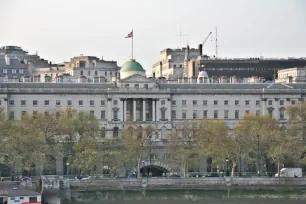
When King Henry VIII died in 1547 his son Edward was too young to be crowned king and his ambitious uncle Edward Seymour arranged to become his main advisor. Seymour made good use of his new powers: he granted himself the title Duke of Somerset and planned the construction of a palace worthy of his new position. He confiscated a number of properties near the River Thames and demolished the existing houses.
His new palatial house, at the time named “Somerset Place” was built in Renaissance style. Seymour could not enjoy his new house for long; in 1551, before the house was fully completed, he was charged with treason and in January 1552 he was executed in the Tower of London.
The building fell into the hands of the crown, and under Queen Elizabeth I it was used as a residence for visiting dignitaries. Somerset House enjoyed its heyday in the early seventeenth century, when Queen-consort Anne of Denmark lived here. She renamed it Denmark House and entertained guests with lavish parties. The royals continued to use the house as a residence until the eighteenth century, by which time Somerset House had started to fall into decay due to neglect.
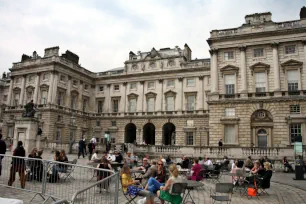
Office Complex
By then it had become obvious that the building was beyond saving, and it was demolished in 1775 to make way for a new building. But unlike its predecessor, the new Somerset House was planned as a government building used to house public offices rather than a royal palace.
William Chambers was appointed as architect. Not to be outdone by his main rivals, the Adam Brothers, who had just built the magnificent (now demolished) Adelphi Terrace nearby, Chambers designed the building we see now: a grand edifice with monumental wings arranged around a large courtyard. The north wing, on the Strand, was built first and was completed in 1780.
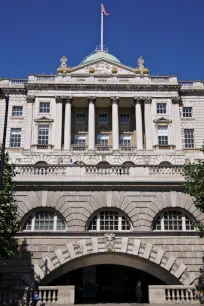
The south wing was completed in 1801, five years after Chambers’s death. The other wings were added much later: the east wing was finished in 1834 and in 1856 the addition of the west wing finally completed the complex.
Center for the arts
The first occupants of Somerset House were the Royal Academy of Arts, the Royal Society, and the Society of Antiquaries. Increasingly, Somerset House also accommodated a number of government institutions, such as the Inland Revenue and the Navy Board. By the end of the twentieth century the building was deemed unsuitable for modern offices and one by one the government institutions vacated the building.
In 1990 the Courtauld Institute moved its art collection to the empty north wing of Somerset House. Several more art galleries and other cultural institutions settled here as well. This prompted a major renovation of the building as well as a transformation of the courtyard, which was used as a parking lot, into a public space with a fountain display. The terrace on the south side of the building, with views over the Thames, also opened to the public.
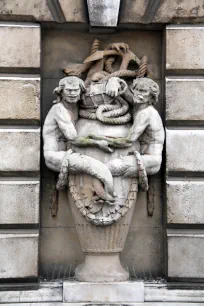
Architecture and sculptures
Somerset House is a massive building designed in the neoclassical style. The north front, facing the Strand, is the smallest and is designed like a giant triumphal gateway. Opposite, the monumental facade facing the river is enormous, measuring 244 meters long (800 feet). It rests on large arches that used to rise out of the river until the construction of the Victoria Embankment in 1864-70 separated Somerset House from the Thames. Before, the arches allowed boats to dock right under the building.
The courtyard is surrounded on three sides by wings with Corinthian style porticoes. Their massive columns support pediments decorated with reliefs. The domed south wing, which houses the Seamen’s Hall, is the most impressive. The other two wings are each crowned with a tiny clock tower. The courtyard itself is vast and measures 106 by 96 meters (350 x 310 ft). Architects Inskip and Jenkins modernized the courtyard and installed the fifty-five fountain jets in the pavement.
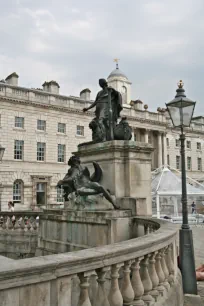
In the middle of the courtyard is a large monument that honors George III, the king who initiated the reconstruction of Somerset House. The monument was created in 1789-90 by John Bacon the Elder. It portrays the king standing in Roman garb on a large pedestal while leaning on a rudder. A lion rests at the king’s feet. In front of the pedestal is another bronze statue that shows Old Father Thames, an allegorical representation of the River Thames.
There are many more nautical sculptures and reliefs visible on the facade of Somerset House, including statues of mythical sea creatures, mascarons of sea gods and other nautical-themed ornaments. Most of these were designed by the Florentine painter Giovanni Battista Cipriani and carved by a variety of sculptors.
Courtauld Gallery
The main attraction in Somerset House is the Courtauld Gallery. This museum has an excellent selection of art from the Renaissance period up to the post-impressionists. The museum is worth a visit just to see a glimpse of the regal interior of Somerset House, which matches its exterior in grandeur.

The collection was founded by Samuel Courtauld, an English industrialist who had a passion for art. In 1931, he provided funds for the creation of the Courtauld Institute, a center for the study of art. He bequeathed his collection to the institute upon his death.
The museum has a collection of artwork encompassing a period from the sixteenth up to the twentieth century. It is particularly renowned for its impressionist and post-impressionist paintings. Among the highlights are «A Bar at the Folies-Bergère» by Manet, van Gogh’s «Self-portrait with Bandaged Ear», Rubens’s «Descent from the Cross» and Lucas Cranach the Elder’s «Adam and Eve». The museum also has a collection of decorative arts, including fine majolica, as well as sculptures from the antiquity to the twentieth century.

